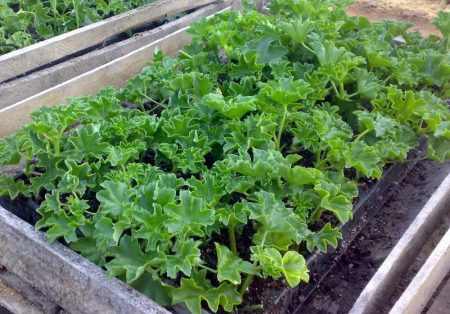
Pelargonium (geranium) is loved by many gardeners. This flower is very unpretentious, it blooms from March to late autumn with red, orange, pink and white flowers.
Creating a whole collection of fragrant pelargoniums is very simple. You just need to know the best time for planting, so that it blooms as soon as possible, and adhere to the simple rules of its breeding.
Content
Rules and terms of breeding
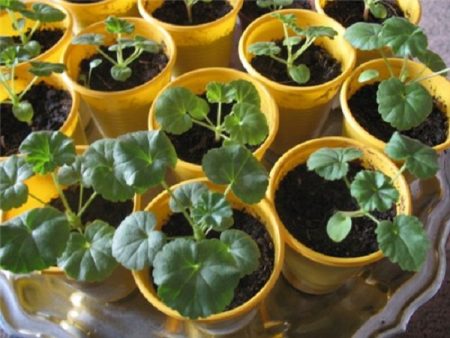
In fact, there are no specific dates for planting pelargonium. It can be cultivated all year round, however, the period of its bloom will depend on the month of planting. Also, when pelargonium blooms, the method of breeding affects.
If you are interested in breeding pelargonium at home, then you need to know about the methods of propagation of this flower. There are several methods for breeding young flowers of geraniums.
Propagation by cuttings
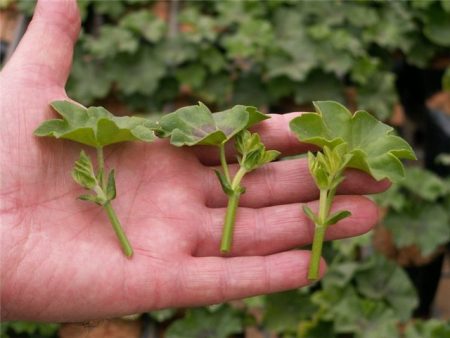
This method is perhaps the easiest to execute, short-term and most effective. And also allows you to save all varietal properties of the mother plant.
The key to a successful operation lies in observing two conditions - maintaining the optimum temperature and constant lighting.
The advantage of this method is that you can deal with cuttings several times a year. However, it is worth considering that in certain months the plant is at rest (November-January), and therefore it will not work to grow a strong plant from cuttings. And if you want pelargonium to bloom already this year, then you need to start propagating it already in March, since it is during this period that all the vitality of the plant is activated, active juice begins. A planted geranium in April will bear flowers only next year.
You can also cut the pelargonium in the fall (September-October), during the planned pruning after flowering. These cuttings during the autumn-winter period will rise well and already next summer will give the first color.
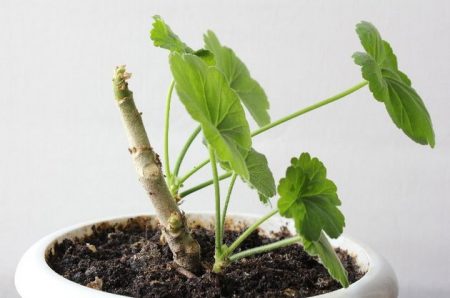
Cherenkovka technique:
- Apical shoots that have 3-4 leaves are suitable for reproduction. The length of the handle should be approximately 7 centimeters.
- Cuttings are cut only with a sterile instrument, and the entire operation is carried out with gloves so that inadvertently not to bring the infection into sections.
- The taken material is removed for several hours in a shaded place so that the cut-off point is pulled by a film.
- So that the cut does not begin to rot, it is sprinkled with charcoal or "Kornevin."
- Cuttings are dipped in water and wait for the formation of roots. Then the escape is seated in the ground.
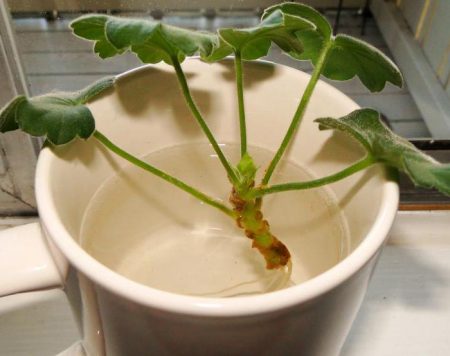
- Overexposure in water can be avoided and the stalk planted immediately in the ground. The soil must be moistened and disinfected in advance.
- Capacities with shoots are covered with a lid or other protective material, creating a greenhouse effect.In some cases this is not required, for example, if the cuttings are strong and healthy.
The plants are provided with comfortable conditions - the temperature in the room should be + 22-23 degrees, air humidity - 80%.
Pelargonium propagated by cuttings, very quickly overgrows with roots, there is practically no waste.
Seed propagation
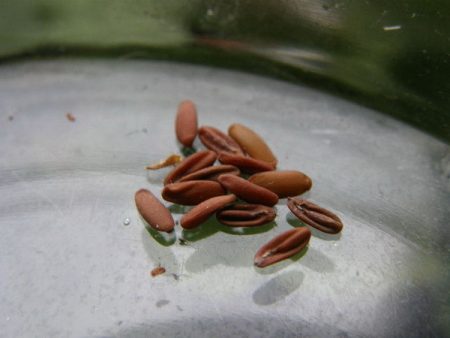
For many gardeners, it is a true pleasure to propagate pelargonium seeds. This, of course, is not such a popular method as the cuttings, however, and it has its advantages. For example, this method allows you to get a new individual plant variety with unique properties.
In addition, pelargonium seeds are very good germination. They grow quickly and amicably. And the flowering of plants grown by seed (and planted in the spring) occurs within 5-6 months.
Sowing geranium seeds can be carried out all year round. However, in the winter period there will be additional chores in the form of artificial lighting, humidity control, etc. Therefore, the spring and summer months are considered the most optimal time for planting geraniums.
Geranium seeds are large, easy to plant. For seedlings, loose and light soil is prepared, with a minimum amount of nutrients (so that the seedlings do not fat). The mixture usually consists of two parts of garden soil and one part of peat or sand. You can also add a little humus, as in a very poor land seedlings will not rise.
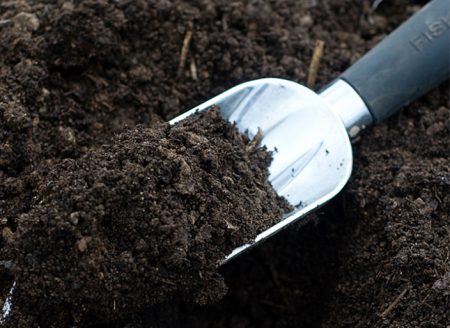
The soil before sowing must undergo a mandatory decontamination procedure. It can be calcined in the oven, spilled with boiling water with the addition of manganese, or steamed. Then the soil is packaged in shallow containers, abundantly watered.
Geranium seeds are laid out on the surface in orderly rows at a distance of two centimeters from each other. Future flowers are sprinkled from above with a centimeter layer of earth and carefully watered (best of all with a spray bottle) with warm water. In order for seedlings to manifest themselves faster, the crops are covered with a film or a transparent cover, creating a greenhouse effect inside.
All that plants need to start growth is a warm and humid environment. Therefore, it is important to ensure that the ground in the container always remains slightly moist. The lack of moisture will quickly turn the earth's surface into a crust, through which fragile sprouts can not break through. Excessive humidity is also detrimental to crops: seeds already before germination simply rot in the ground.
Before emergence of seedlings, it is better to keep the boxes with crops in a well-lit place, but not in direct sunlight. And when the green shoots sprout evenly, then the film is removed from the box, and seedlings are put on the windowsill to rise, swimming in the warm sun.
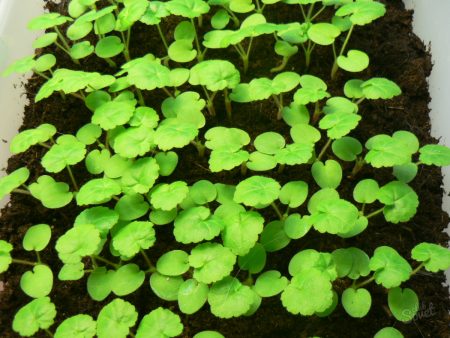
If crops were made at the end of March, then the number of hours of sunshine is enough to support the growth of seedlings. But planted geranium in February will need to be artificially illuminated.
The formation of seedlings is very exciting to watch. The first juicy and such fragile seedlings will appear in a week. And after 14-18 days, the shoots will acquire 3-4 leaves. This will indicate that the seedlings have grown enough to continue their long life in a separate container.
The absolute majority of plants do not like picking (geranium, by the way, too), therefore, the procedure should be treated responsibly.
For seedlings, larger containers are selected, the volume of which is 200 milliliters (8 centimeters in diameter). Geraniums are transplanted into fresh soil, which is supplied with a small amount of mineral components. Using a spatula or a teaspoon, each flower bush is carefully transferred to a new container, being careful not to damage the fragile white roots. After transplanting, seedlings are watered and exposed in the sun.
After transplantation, it remains only to wait for plentiful and rainbow flowering, which will please the eye for a month.
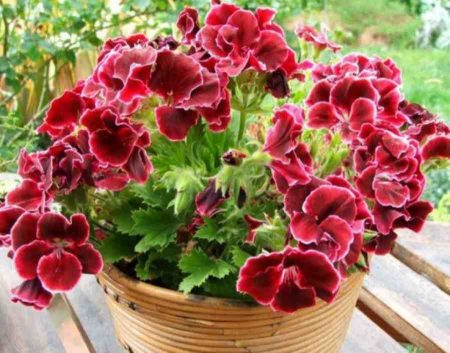
Along with cuttings and seed propagation, there are two other simple ways to increase the number of pelargonium flowers at home. One of them is the division of the bush. The essence of the method is that during a geranium transplant, for example, in autumn, from open ground into a pot (or just when changing the container), the bush is carefully divided into separate parts. New bushes are planted in fresh and light soil, watered and looked after in the same way as all other plants.
Pelargonium, as you can already understand, reproduces well vegetatively. You can plant a whole garden of flowers through a leaf. The subtlety of this method is that it is necessary to select the sheet as correctly as possible, which will serve as material for breeding. On the plant, you need to choose the healthiest and largest leaf with a strong handle. It is carefully cut at an acute angle and placed in water. After a few days, the shoot will be overgrown with white roots. As soon as the root system has grown sufficiently, the leaf is transplanted into the ground.
Pelargonium care features
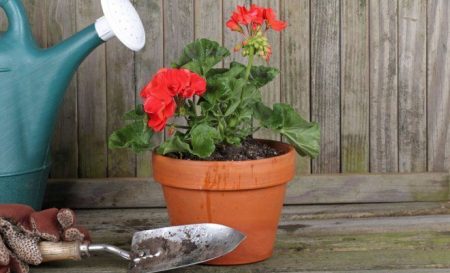
Pelargonium is one of the most unpretentious flowers. Without much work, you can grow lush seedlings and provide it with abundant flowering. But, if you try and pay a little more attention to geranium plants, you can achieve flowering throughout the year.
The rules for the proper maintenance of pelargonium are simple. They include:
- watering;
- control of external factors;
- pruning
- top dressing;
- protection against diseases and pests.
Watering
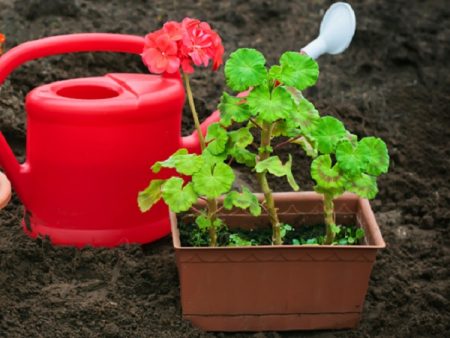
Like absolutely all plants, geranium needs water. You can not spray the bushes and not monitor the humidity, but the flow of moisture to the roots should be constant. The main thing in the issue of watering is to observe subordination not to flood the plant. Geranium simply will not survive life in a too humid environment, as its root system is quickly affected by mold and other dangerous fungal diseases, especially in winter. In general, geranium can be attributed to drought-resistant crops, but this does not mean that geranium can be kept in constant stress due to lack of water. It is worthwhile to understand that the less water a plant gets, the weaker its flowering will be, and the flowers will be crushed. Based on the foregoing, the watering regime is built according to the scheme - 1 time in 4-5 days.
External factors
Geranium is an ideal indoor flower. The plant feels great at room temperature + 20-25 degrees, and in winter it can live even in cooler conditions. The only condition is less drafts.
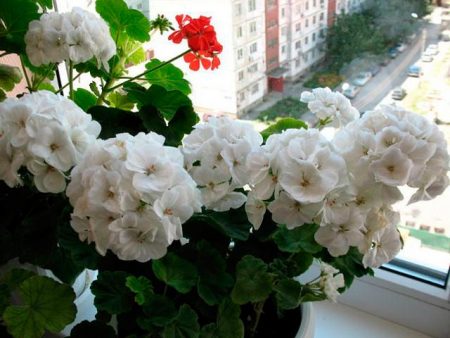
In the winter months, being at rest, the plant feels comfortable at temperatures below 14 degrees. It is best to place a tired plant in a room where the temperature is only 6-8 degrees. And if you keep blooming geranium for several days at a minimum temperature, then it will cease to bloom.
You do not need to be an experienced gardener to know: all flowers are photophilous. Pelargonium is no exception. It is best to arrange a flower garden on the windowsill, so that the flowers are constantly lit. But the lack of light will quickly affect the quality of flowering: the buds will form small and dull. And in the event of a critical lack of light, pelargonium can discard leaves.
An abundance of light saturates the leaves with juice and color. The plant looks (and grows) healthy, blooms profusely and exudes a strong aroma inherent in this flower.
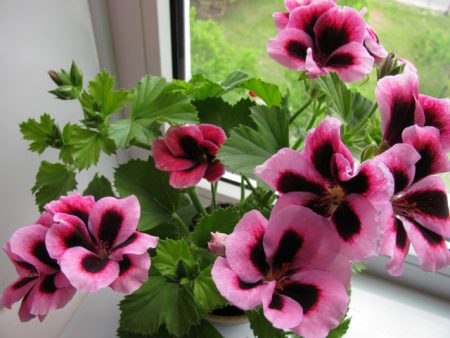
You need to take a small pot. Earth geraniums do not need much. The faster the roots braid around a lump of earth, the faster the plant will bloom, and the smaller the pot, the more flowering will be. In large pots, the plant may not bloom at all, it does not need it - life is already good, why bother? In one pot you can even plant several cuttings.
Pruning
After flowering, the plant is pruned. First of all, cuttings are cut from the bush for subsequent propagation, and all faded areas are also removed. Trim branches need mercilessly, leaving stumps long 5-7 centimeters. Soon they will begin to grow densely young shoots. The shorter the pruning will be carried out, the lower the crown of the bush will form and good branching.
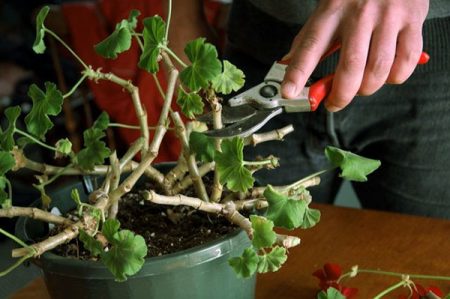
In order to form a stunted lush bush, pruning is better in the spring, after wintering, while the plant is still sleeping. During this period, stronger and healthier shoots are formed. Pruning in the spring involves removing weak twigs and shortening too long ones. You can’t cut everything aimlessly: a few buds should remain on the cut branches.
Pest and Disease Control
If the geranium is properly looked after, then the flower can live a long life without disease. However, sometimes leaves and roots can be affected by ailments, so you should know the plan of action if suddenly a nuisance occurs and the geranium is on the verge of death.
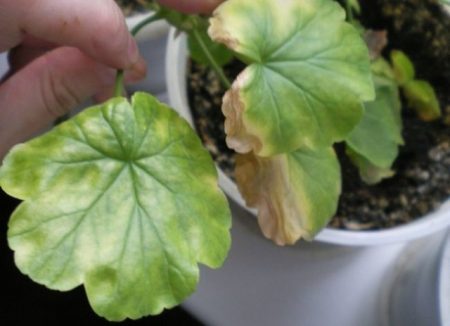
Like the vast majority of plants, pelargonium becomes sick when it is in constant shade, the soil in which it grows is too waterlogged. As a result, humidity and fever do their job - the flower is affected by the fungus. The main diseases of pelargonium: gray rot, leaf rust, powdery mildew, nematode.
The plant is most often affected by gray rot in the winter, when it is easiest to fill the flower and supercool on the windowsill. To avoid an insidious disease, it is necessary to competently water and air, because a lack of fresh air leads to oxygen starvation of the roots and the whole system of the flower structure.
Often yellow small spots appear on flower leaves. Such damage to the leaf plate indicates the development of another insidious disease - leaf rust. This disease develops due to improper care of the plant.
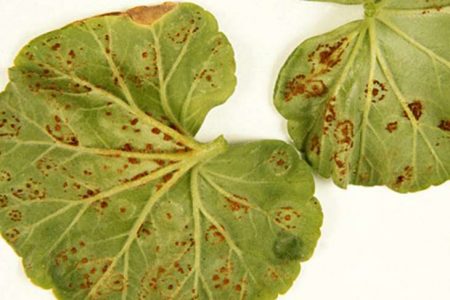
So that fungal diseases do not become permanent flower companions, the plant is regularly treated with fungicides (for example, Topaz, Topsin, Skor preparations) and follow the basic rules for caring for a delicate flower.
Various small insects often settle on geraniums, which spoil the appearance of the plant and gradually suck out all the vital juices and geranium withers. The main pests of pelargonium:
- Whitefly - feeds on plant juices, localized at the bottom of the stem;
- Aphid - affects leaflets, multiplies rapidly;
- Thrips, ticks, mealy worms - appear on all parts of the plant.
It is important to regularly inspect the bushes for parasites. If they appeared, only the treatment of the flower with an insecticidal preparation can save the situation.
Feeding rules
Pelargonium fertilizers are needed only in the spring-summer period, during the flowering period. In winter, all dressings are excluded, since the plant is resting. Top dressing is applied 2 times a month, combining them with watering.
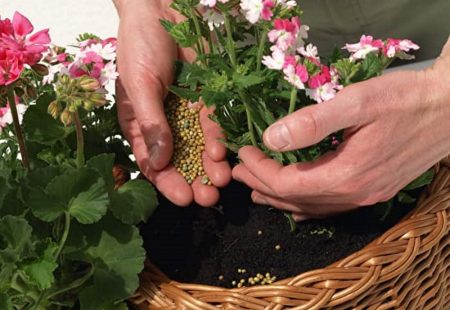
For a full life of pelargonium, four basic elements are needed:
- nitrogen;
- potassium;
- phosphorus;
- iodine.
All these elements can be introduced in a single component, but it is best to arrange cocktails from several trace elements at once.
To grow a lush green crown - a stem, leaves, roots - at the initial stage, the bush needs nitrogen. It is brought into the ground in the first months of spring. If the plant does not have enough nitrogen, then it will grow very slowly, and the color of the green will become faded.
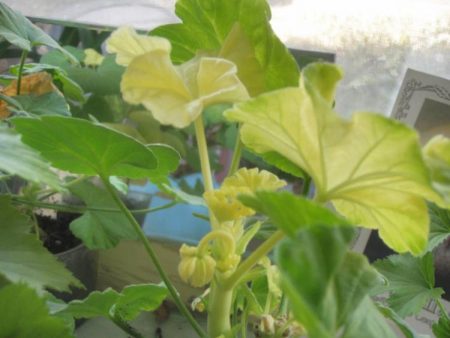
Nitrogen is found in organic compounds, which are added under pelargonium with extreme caution, as it can harm the plant. For flowering, it is good to water the geranium with a solution of bird droppings, cow manure (you can use only old manure).
During the opening of the buds, it is the turn of another element - potassium. Now he is the chief builder of pelargonium, or rather the artist of flowers. And phosphorus will stimulate the strength of leaves and stems.
A colossal amount of energy is expended by a plant on flowering. To make up for it, the tired flower system needs to be nourished with multivitamins, which include various minerals such as iron, sulfur, manganese, boron, magnesium, copper, zinc, calcium. If you provide geranium with everything you need, then all plant systems will work properly for several months and delight the owner with again and again opening buds.
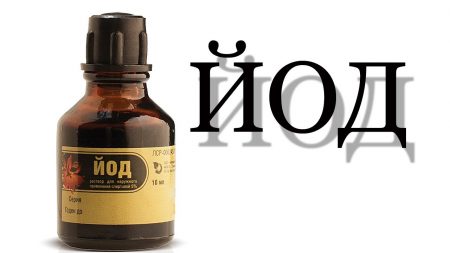
Often, gardeners to stimulate the formation of many flowers contribute to the earth a solution of iodine and hydrogen peroxide. It is very simple to prepare such top dressing, and the effect can be seen already after 2-3 procedures.
Technique for feeding iodine:
- The soil is well moistened.
- Make a solution of 1 drop of iodine, 1 liter of water and 1 milliliter of hydrogen peroxide.
- Mortar is poured on the ground at the walls of the pot, preventing liquid from entering the leaves or trunk.
- Fertilizer consumption - 50 grams at a time.
- After 3-4 weeks, the procedure can be repeated.
- The procedure is carried out before the beginning of abundant flowering.
- It is not recommended to use such top dressing often, since the concentrate can burn the roots of the flower.
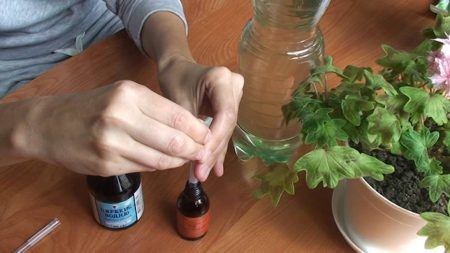
By the way, for a violent color, you can add B vitamins - B1, B6, B12 to the composition of top dressings, which you can buy in a pharmacy.
Organic food dressing
In the household, there is always a suitable remedy for feeding geraniums. For example, milk. It contains calcium, phosphorus, potassium, sodium, amino acids and fatty acids. In general, everything that is necessary for the growth and flowering of our plant.
Pelargonium responds very well to milk fertilizer. The solution is prepared from 1 liter of water and 100 milliliters of milk. With the finished mixture, water the earth under a bush, alternating with ordinary watering.
And, of course, the well-known yeast method of top dressing, which many plants, including pelargonium, willingly “eat”, is known to all. Usually a solution of water (1 liter) and yeast (100 grams) is used during the propagation of cuttings (for rooting cut branches) or as a root top dressing, adding a little sugar to the mixture.
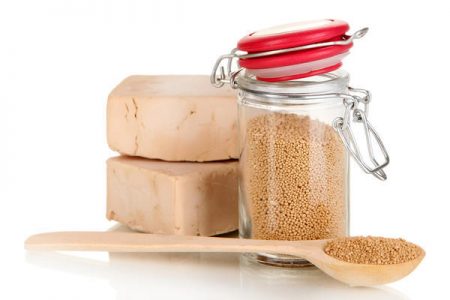
What else can be used as a fertilizer for geraniums:
- Sugar. For abundant flowering, radical feeding of a sugar solution is made. To increase the efficiency, EM preparations should be added (for example, Baikal EM-1).
- Ash. Its composition contains a large amount of potassium, which is necessary for multicolor plants.
- Eggshell. Great source of calcium. Often the shell is introduced as drainage or an infusion is prepared from it.
There are a lot of feeding methods. You can use traditional fertilizers, purchased, or turn to folk wisdom and feed your flowers with homemade products. However, it is worth remembering that a measure must be present in everything. It is important to know when to feed plants and when to leave them alone.
Tips for gardeners:
- liquid top dressing should always be combined with watering;
- after fertilizing, the earth must be loosened;
- geranium can not be fed before the transplant and immediately after it;
- patients with pelargonium can not be saved with fertilizers.
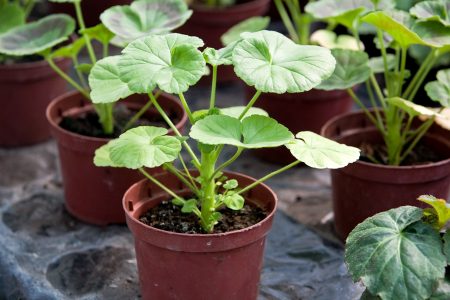
Recommendations for the cultivation of pelargonium:
- Young plants have more flower stalks, but if there is a desire to preserve old plants, then in autumn they need to be transplanted into smaller pots with light soil and pruned heavily.
- Before the buds appear, you need to pinch the top of the plant - for a more abundant color.
- Geranium loves potash fertilizers, but the flower does not treat organics well.
- Small pots are selected under the flower bush. If the capacity is many times larger than the plant, then the excess earth will quickly condense, and water will accumulate on the surface. As a result, there is a great risk of decay of weak roots. You should be aware that the roots must completely braid the ground in the pot. And the faster this happens, the faster the flowering will come.
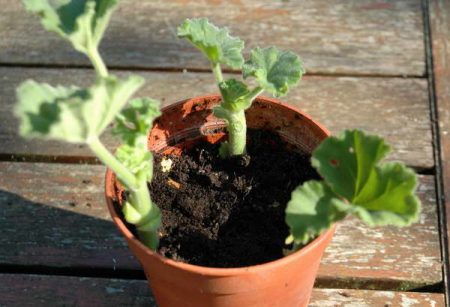
- Plants grow well in both alkaline and acidic soil, but better if the pH is 7.
- Continuous flowering can be achieved by breaking off faded peduncles.
- Pelargonium is able to live at any temperature, and in sultry summer it blooms well in the sun, but still gravitates toward cooler weather. In autumn, at 10-12 degrees, she feels more comfortable.

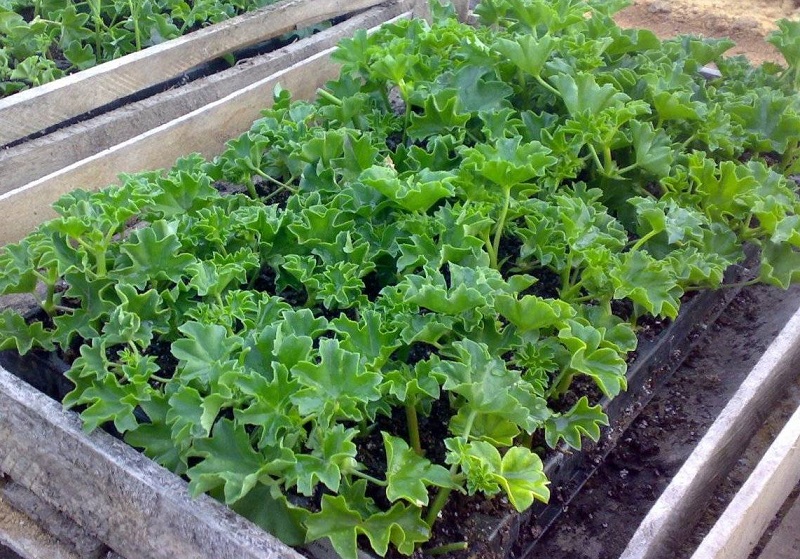
Thanks to the author for the detailed description. Very helpful article.